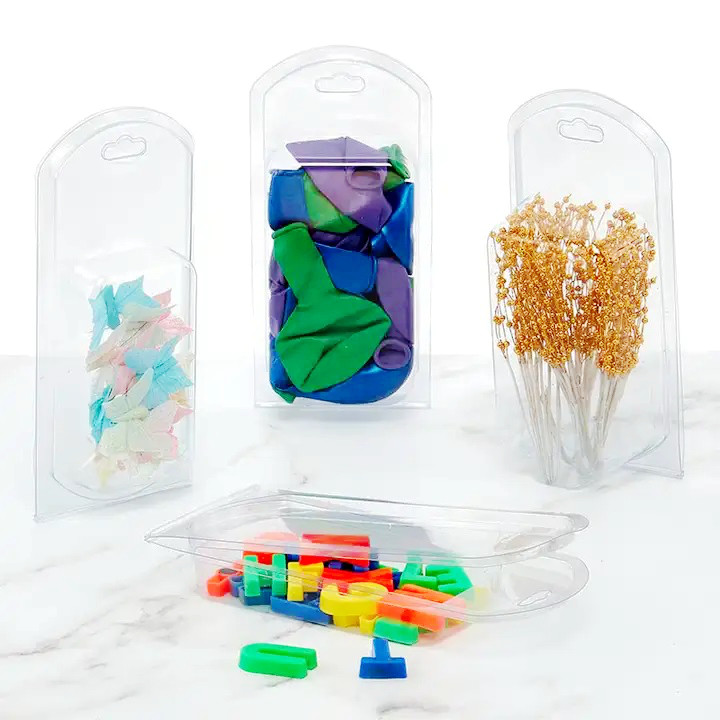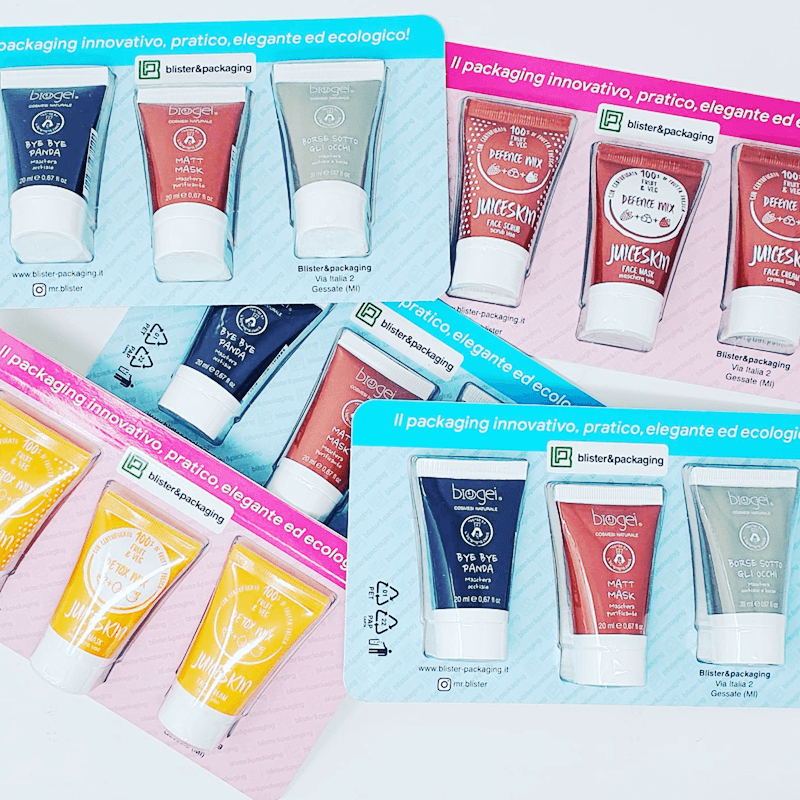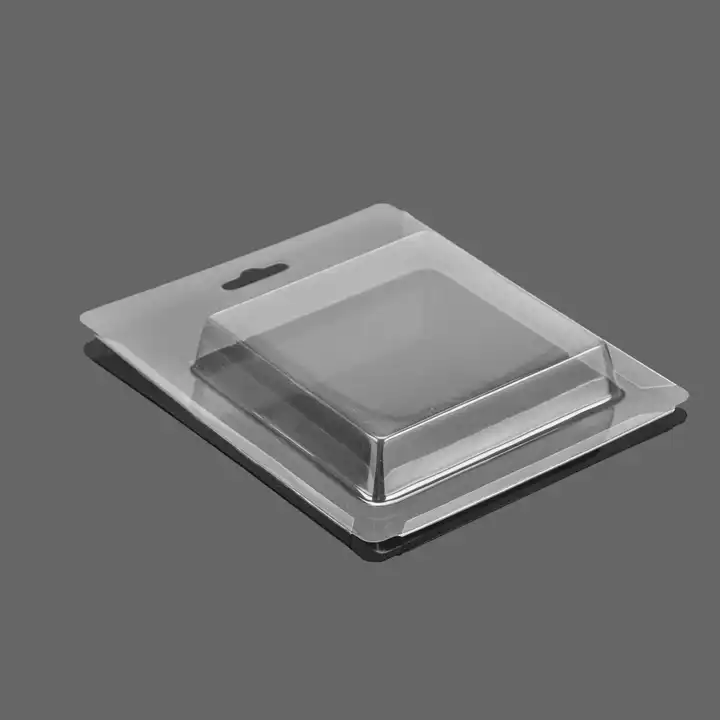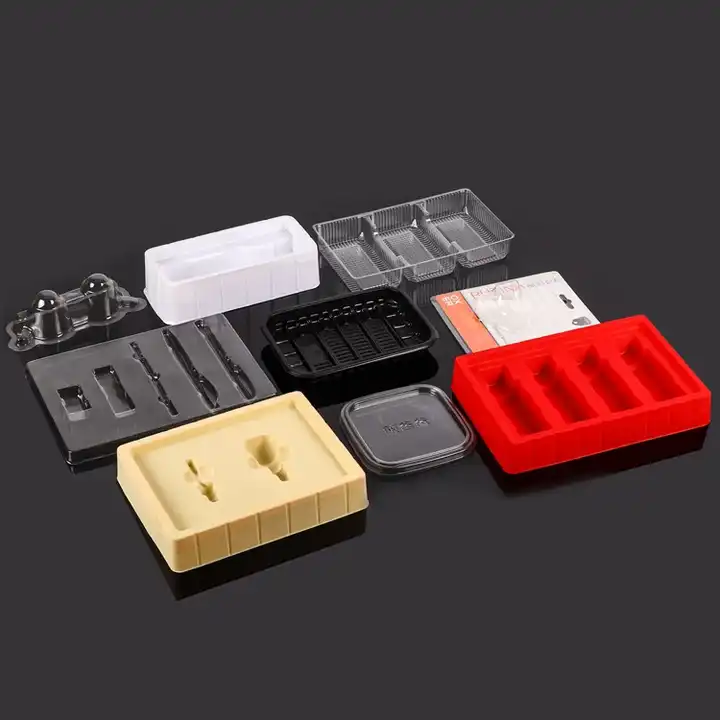Fornitori di imballaggi in blister personalizzati
- 6 termoformatura confezione in blister linee (semiautomatico, Completamente automatico)
- Materiale passato SGS, ROHS, Proposta della California degli Stati Uniti 65, SVHC e TPCH test.
- Sala stampi propria per una gestione rapida e accurata dello sviluppo dei campioni e della produzione di massa
- Può assistere nella personalizzazione dell'imballaggio in blister per prodotti e marchi
- Selezione di Riciclabile + Degradabile + Materiali compostabili
- 1 settimana per lo sviluppo di stampi, 2 settimane per la produzione in lotti, capacità giornaliera 100,000PZ
Materiale :PVC APET PETG PP PS Colore trasparente o personalizzato
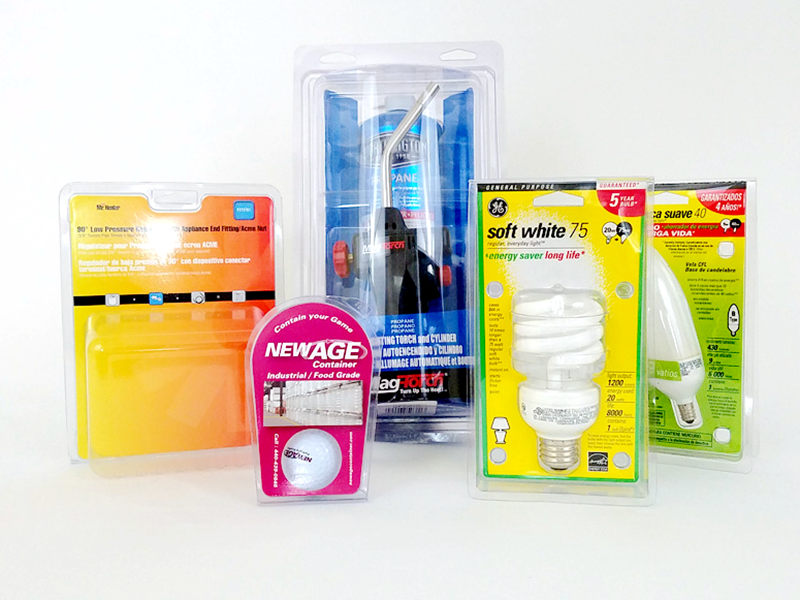
L'imballaggio a conchiglia offre un'apertura semplice e un contenimento sicuro per i tuoi prodotti, caratterizzato da un materiale chiaro e visibile. Questa confezione garantisce un facile accesso racchiudendo in modo sicuro i tuoi articoli, offrendo sicurezza e visibilità.
L'imballaggio in blister con sigillo facciale è una soluzione di imballaggio sicura e visivamente accattivante che racchiude completamente un prodotto all'interno di una cavità di plastica sigillata. Offre un'ottima visibilità, mettere in risalto il prodotto garantendone la protezione contro manomissioni e danneggiamenti.
Gli imballaggi in plastica scorrevoli rappresentano una soluzione di imballaggio versatile e sicura. È sufficiente far scorrere la scheda di carta stampata fuori dall'involucro di plastica sigillato per un facile accesso al prodotto. Fornisce visibilità mantenendo il prodotto al sicuro.
Il vassoio termoformato è una soluzione di imballaggio trasparente affidabile e personalizzata, che mira a fissare e visualizzare saldamente i prodotti. Il vassoio ha durata e visibilità, che mostra efficacemente gli elementi, garantendo al tempo stesso la sicurezza durante il trasporto.
Produttore leader di imballaggi in blister in Cina
Il packaging agreen® è stato fondato nel 2008, situato a SHENZHEN, Cina. La nostra fabbrica ha superato ISO9001:2015 così come molti rapporti di ispezione e certificati di ispezione per Blister Packaging. Abbiamo più di 30 lavoratori, 3 controllo di qualità, 2 Controllo qualità, tecnologia di produzione e gestione del personale, con un totale di 53 dipendenti allo stato attuale.
Imballaggio in blister personalizzato :La guida completa
Che tipo di imballaggio in blister è adatto ai tuoi prodotti?
L'imballaggio in blister è un'opzione economica per creare confezioni durevoli, trasparente, e a prova di manomissione. Realizziamo una varietà di forme e possiamo progettare su misura un blister che metterà in mostra il tuo prodotto nel miglior modo possibile. Anche se ci sforziamo di fornire ai nostri clienti un prezzo molto competitivo, non sacrificheremo la qualità per farlo. Tutti i prodotti di imballaggio in blister sono testati per la chiarezza, spessore del muro, e conformità dimensionale prima di lasciare il nostro stabilimento.
confezione blister con sigillo facciale
Il blister in plastica trasparente può essere utilizzato insieme a un blister in cartone per mantenere il prodotto in piena vista affinché il cliente possa esaminarlo. La confezione blister è attaccata alla scheda blister attraverso un processo di termosaldatura che consente di esporre il prodotto in un'ampia varietà di modalità. Il blister di plastica è fissato alla parte anteriore del cartone, contenere e proteggere il prodotto
Vetrino in cartoncino intero Confezione in blister
A differenza della confezione blister a conchiglia termosaldata, la sua funzione scorrevole ti aiuta a chiuderlo e aprirlo facilmente.
Il blister scorrevole è una sorta di blister termoformato, che è piegato su tre o quattro lati. Quindi le carte con supporto completo scivolano nel blister senza alcun attrezzo.
Imballaggio a conchiglia
Imballaggio a conchiglia (chiamato anche imballaggio di vongole o confezioni di vongole) è un tipo di imballaggio in blister. A differenza di un normale blister, l'imballaggio a conchiglia non ha il retro in cartone. Invece, ha un retro in plastica che è incernierato alla parte anteriore della confezione, o al lato o alla base.
Vassoi blister termoformati
Progettiamo e produciamo vassoi in plastica termoformati personalizzati utilizzando la nostra vasta esperienza interna di progettazione e attrezzaggio. Possiamo produrre vassoi in plastica in una varietà di materiali e colori che includono il PET, PVC, P.E, PP e Polistirolo.
Gli usi comuni per un vassoio termoformato in plastica includono inserti di imballaggio o vassoi di spedizione. A seconda dell'uso finale, i materiali plastici utilizzati per fabbricare un vassoio possono variare. Per la spedizione, magazzinaggio, e vassoi per la movimentazione dei materiali, materiali meno costosi possono essere utilizzati per fornire un vassoio durevole e protettivo senza necessità di chiarezza. Il nostro team di progettazione lavorerà con voi per determinare il design e il materiale migliori per la vostra applicazione. Tutti i vassoi sono fabbricati con cura e impilati impilati per assicurare qualità e facilità d'uso presso il vostro impianto, oltre a risparmiare sulla spedizione e lo stoccaggio.
 Imballaggio in blister La termoformatura è un processo di riscaldamento di un foglio termoplastico e di posizionamento su uno stampo, sotto vuoto, finché non si raffredda. Lo spessore del materiale determina se il processo di produzione utilizza fogli laminati (calibro sottile) o fogli impilati pretagliati (calibro pesante). Il materiale sottile è dominante nel settore degli imballaggi usa e getta, soprattutto nei mercati al dettaglio. Il materiale pesante o spesso è comunemente usato come componenti permanenti in cose come i frigoriferi, automobili e terme per citarne alcuni.
Imballaggio in blister La termoformatura è un processo di riscaldamento di un foglio termoplastico e di posizionamento su uno stampo, sotto vuoto, finché non si raffredda. Lo spessore del materiale determina se il processo di produzione utilizza fogli laminati (calibro sottile) o fogli impilati pretagliati (calibro pesante). Il materiale sottile è dominante nel settore degli imballaggi usa e getta, soprattutto nei mercati al dettaglio. Il materiale pesante o spesso è comunemente usato come componenti permanenti in cose come i frigoriferi, automobili e terme per citarne alcuni.
Per produrre un imballaggio in blister di buona qualità, c'è bisogno di prestare particolare attenzione ai due punti: stampo per la formatura di blister e tecnologia di lavorazione.
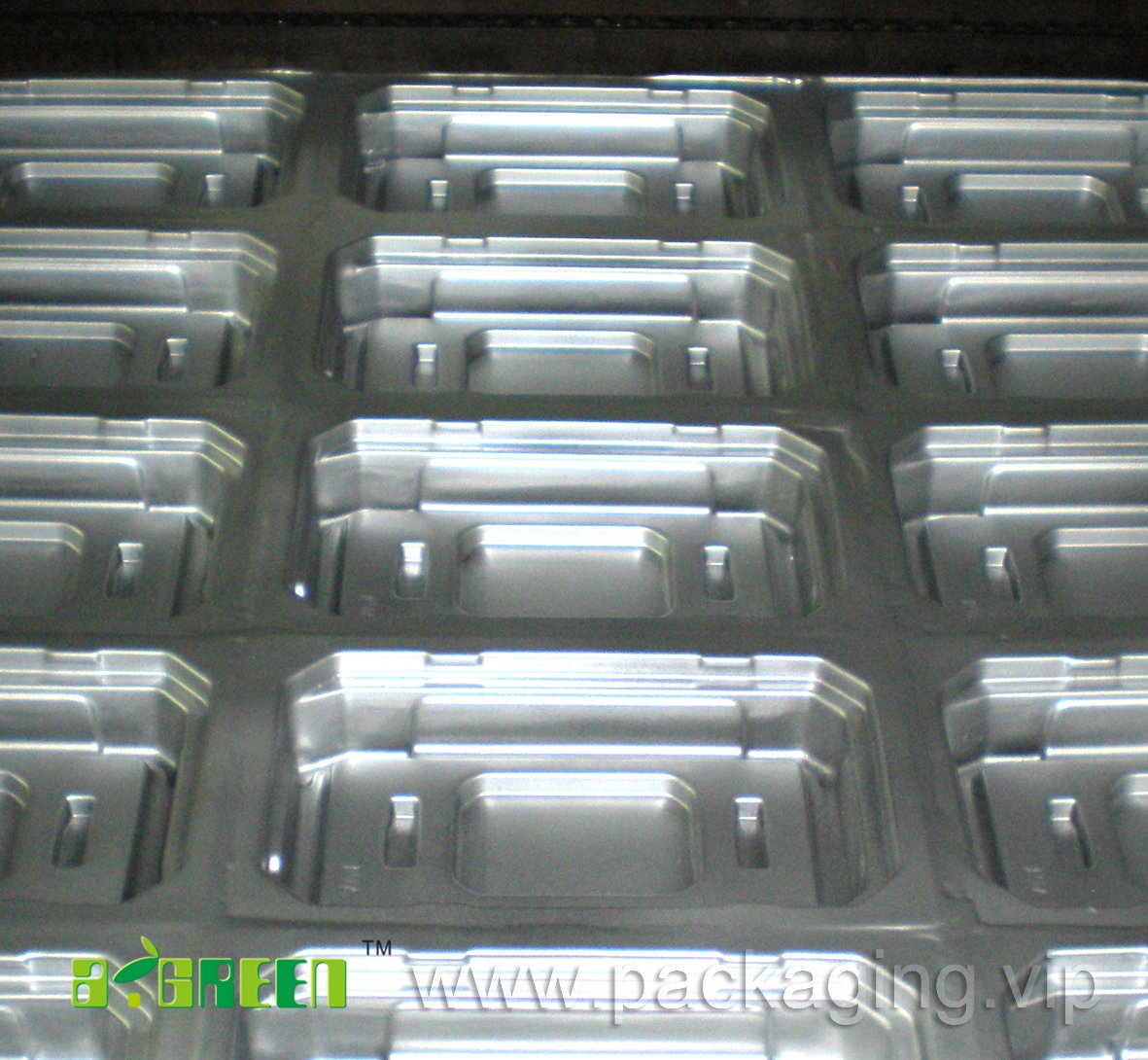
Imballaggio in stampo
Lo stampo gioca un ruolo molto importante nella qualità della confezione blister personalizzata. Generalmente, ci sono stampi in gesso, stampo in rame, e stampo hardware per stampi per la formatura di blister.
Lo stampo in gesso è facile da realizzare, anche il tempo è breve ( Di 2-4 giorni). È favorevole alla modifica della confezione del prodotto. Rispetto ad un altro stampo, il suo costo è il più basso. A causa del colore originale dello stampo in gesso, la trasparenza del blister realizzato con stampo in gesso è inferiore alla trasparenza del blister realizzato con un altro stampo. Quindi è applicabile principalmente alla conferma del campione e ai bassi requisiti di trasparenza dell'imballaggio del prodotto.
Lo stampo Cooper è uno stampo in metallo realizzato sulla base di stampi in gesso, che sono relativamente durevoli. Lo spessore dello stampo in rame per blister è di circa 0,5-0,8 mm, e il tempo di realizzazione è circa 5 giorni ( compreso il tempo di realizzazione dello stampo in gesso). La superficie dello stampo in rame è liscia, quindi l'aspetto e la trasparenza del blister prodotto sono buoni. Anche, il suo costo dello stampo è relativamente basso, in modo che sia lo stampo per la formatura dell'inserto per blister più comunemente usato.
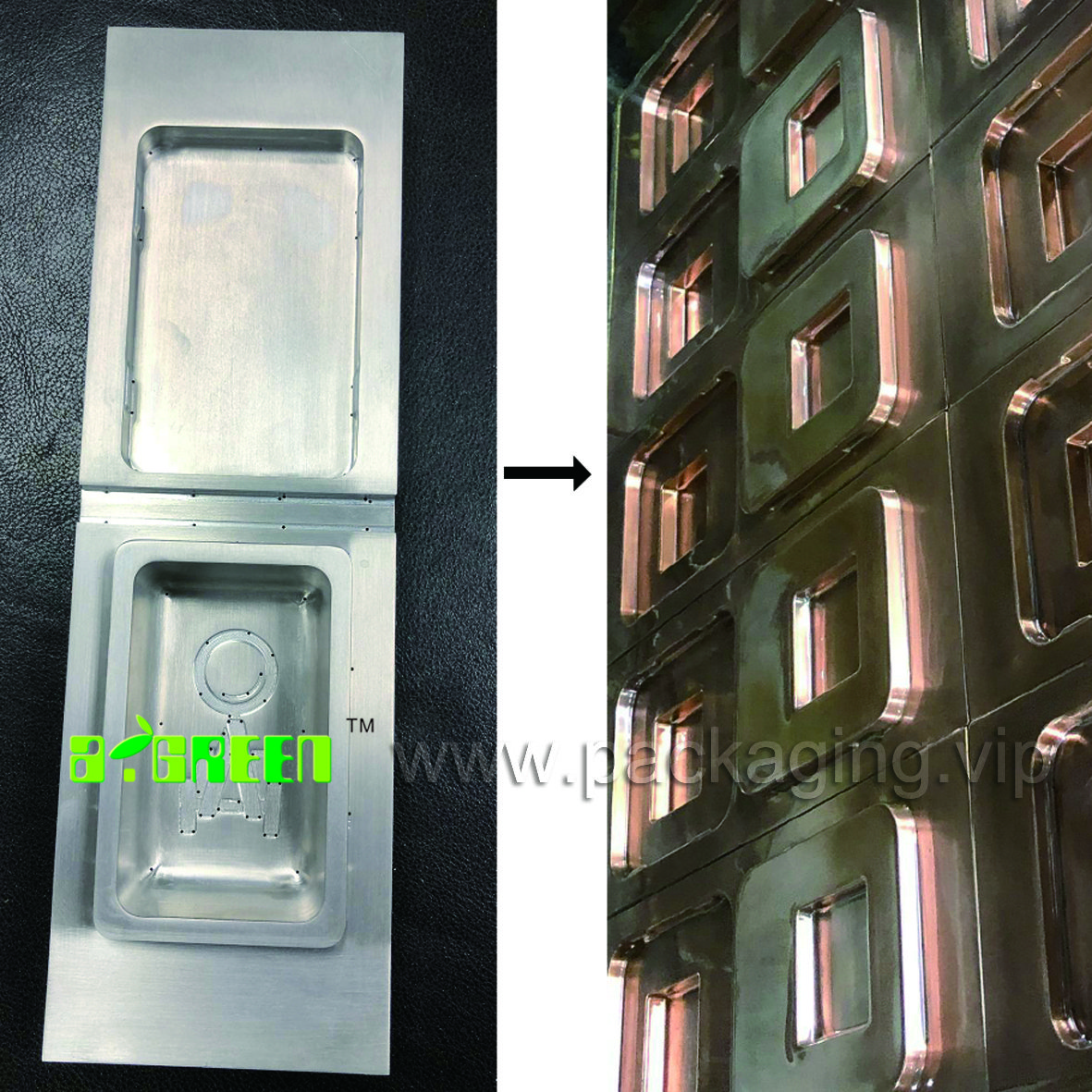
Lo stampo in alluminio deve essere basato su un progetto 3D o su un campione di prodotto, tramite CAM e altri programmi software di programmazione, completato dalla lavorazione di macchine utensili CNC La precisione dello stampo in alluminio è molto alta, il contorno e l'angolo delle confezioni blister prodotte sono relativamente belli. Rispetto agli altri due stampi, il suo prezzo è il più alto, ma la sua durata e l'efficienza produttiva sono più elevate, risparmio di tempo e risparmio di energia elettrica, e il tasso di rifiuto è molto basso. Questo stampo è adatto per imballaggi con elevati requisiti estetici e dimensionali. È la prima scelta per la produzione di massa e per gli elevati requisiti della produzione di blister.
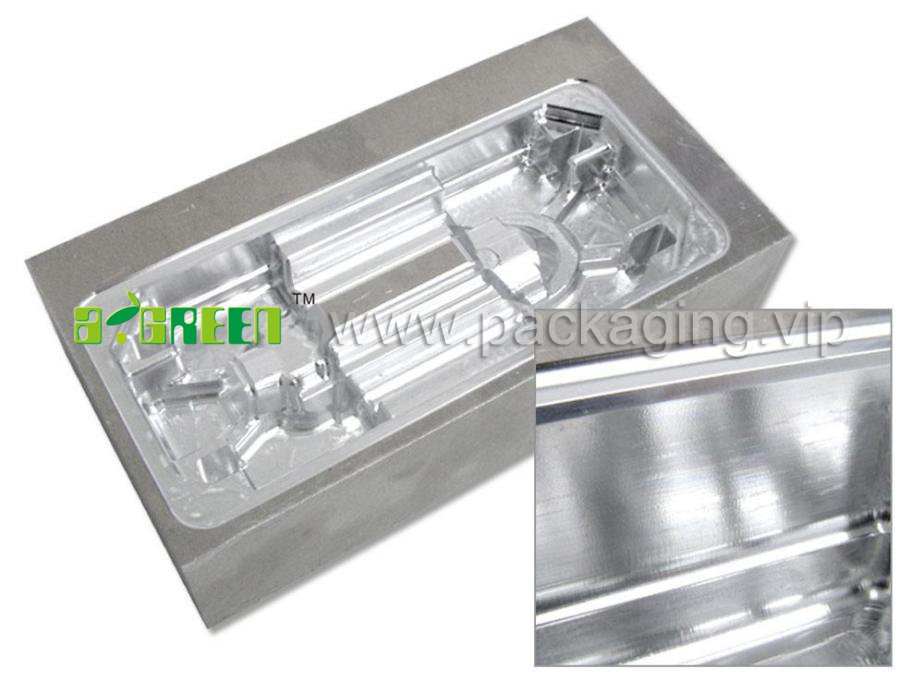
Conosciamo il tuo settore e lavoreremo a stretto contatto con te per creare una soluzione di imballaggio che guidi il tuo marchio e la tua attività, dall'ideazione alla produzione fino all'esposizione al dettaglio.
Imballaggio in blister riciclato: materiale riciclabile dal 30% al 100%.
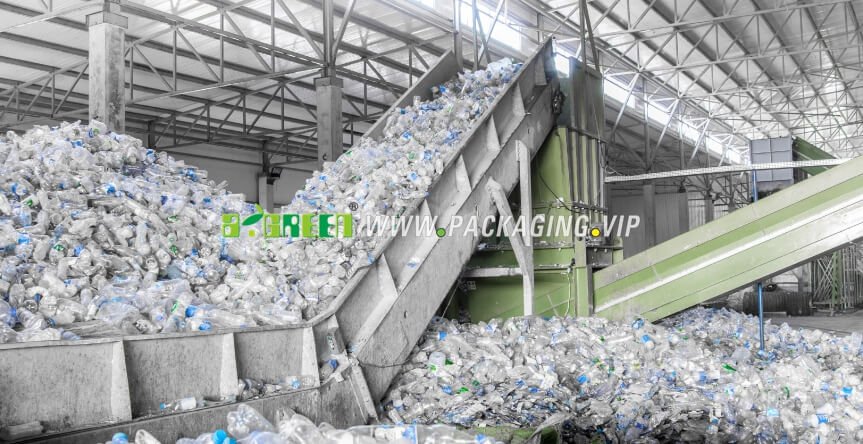
Compostabile, un nuovo materiale per la biodegradazione anaerobica
Il nuovo materiale di degradazione microbica anaerobica è costituito da plastiche tradizionali iniettate in materiali organici anaerobici. Il nuovo materiale introduce la plastica nella fase di biodegradazione attraverso attività chimiche causate da batteri, e alla fine rimangono solo il gas naturale e la bioenergia. Può effettuare la degradazione microbica nelle discariche di rifiuti attraverso la digestione anaerobica, e sostenere il degrado marino (Requisiti di divieto di plastica europei e americani). ASTM D5511
Principio della degradazione di nuovo materiale da parte di microrganismi anaerobici
Biodegradazione anaerobica di nuovi materiali attraverso una serie di processi chimici e biologici per introdurre la plastica nell'ambiente anaerobico della biodegradazione (questo processo è chiamato assimilazione biologica). Consentire ai microrganismi di creare una struttura di biofilm per penetrare nella plastica. Finché il biofilm si forma in condizioni anaerobiche/anaerobiche, è in discarica e ambienti di acque profonde; Allo stesso tempo, aiuta ad espandere la struttura molecolare, creare più spazio per i microrganismi, e inviare segnali chimici sulla catena polimerica per attrarre altri microrganismi a mangiare la plastica, che migliora il tasso di biodegradazione, in modo che i prodotti in plastica producano solo anidride carbonica, biogas (metano) e humus (materia organica), che è lo stesso processo biologico e residuo della materia organica. Quando pet prodotti in plastica (fogli e bottiglie) vengono utilizzati e gettati in discarica o in acqua di mare, la biodegradazione dei prodotti in plastica PET (fogli e bottiglie) può essere promosso in due modi: Primo, come attrattivo per la crescita di microrganismi su e nelle materie plastiche per animali domestici; Secondo, attraverso l'indebolimento o attraverso la debolezza nella catena dell'animale domestico o in altre forme per mostrare più debolezza. Quando nuovi materiali vengono aggiunti alla miscela di plastica per animali domestici per la degradazione anaerobica, interferirà con la miscela di plastica per animali domestici. In questo momento, gli enzimi nelle discariche o nell'acqua di mare cercheranno punti deboli nella catena dell'animale domestico, ridurre la forza legante della catena dell'animale domestico, interferire con l'emissione di carbonio dell'animale domestico, e rendere la plastica per animali domestici più facile da utilizzare come fonte di cibo per gli enzimi. La degradazione anaerobica in natura si verifica continuamente, perché il processo è relativamente lento, quindi non è facile essere individuati. Tuttavia, la plastica per animali domestici aggiunta con nuovi materiali di degradazione microbica anaerobica può accelerare notevolmente il processo, che consente alla plastica per animali domestici di completare il processo di biodegradazione a una velocità maggiore. Il processo di biodegradazione include quanto segue: fase aerobica – in questa fase, Gli enzimi e le sostanze chimiche di decomposizione agiscono come catalizzatori per il biofilm che ricopre la plastica degli animali domestici. Durante questo periodo di tempo, i microrganismi aerobici si formano gradualmente, e l'umidità nella spazzatura si accumula continuamente. L'igroscopicità delle plastiche per animali domestici standard è relativamente piccola, ma il masterbatch porterà a un ulteriore rigonfiamento e indebolirà il legame polimerico. Questo crea spazio molecolare per la crescita microbica, che avvia il processo di degradazione aerobica, in cui l'ossigeno viene convertito in anidride carbonica. Anaerobico, stadio di non metanazione - quando la concentrazione di ossigeno è sufficientemente ridotta, inizia il processo anaerobico. Nella fase iniziale (idrolisi), le colonie microbiche fagociteranno le particelle e ridurranno i polimeri macromolecolari a monomeri più semplici attraverso un processo enzimatico. Il masterbatch organico porta a un ulteriore rigonfiamento e apertura della catena del polimero PET e aumenta il quorum sensing. Ciò stimola ulteriormente i microrganismi ad aumentare la loro colonizzazione e il consumo di catene polimeriche. Col tempo, si verificano gli acidi, in cui i monomeri semplici vengono convertiti in acidi grassi. In questa fase, la produzione di anidride carbonica avviene rapidamente. Anaerobico, metanogeno, colonie microbiche instabili continuano a crescere, inghiottire la catena polimerica dell'animale domestico e creare sempre più spazio molecolare. In questa fase, viene prodotto acido acetico e gli acidi grassi vengono convertiti in acido acetico, diossido di carbonio, e idrogeno. Mentre il processo continua, il tasso di CO2 diminuisce e la produzione di idrogeno si arresta. Anaerobico, stadio stazionario della metanogenesi: lo stadio finale della decomposizione coinvolge la metanogenesi. Mentre le colonie microbiche continuano a divorare il resto della superficie del polimero PET, l'acetato viene convertito in metano e anidride carbonica, e si consuma idrogeno. Questo processo continua fino a quando l'elemento rimanente è humus. Questo terreno altamente nutriente crea e migliora l'ambiente per i microrganismi e migliora la fase finale della decomposizione.
Applicazione e caratteristiche di nuovi materiali per la biodegradazione anaerobica
Applicazione: plastica accelerata (ANIMALE DOMESTICO) può essere miscelato con plastiche esistenti nel processo di biodegradazione in discariche piene di microrganismi anaerobici attivi (discariche di rifiuti e mare profondo), e poi miscelato direttamente nello stampaggio ad iniezione, stampaggio ad aspirazione, soffiaggio, coestrusione multistrato, e altri processi attraverso la tramoggia.
caratteristica:
(1) Pulito e sicuro. Proprio come la materia organica, i microbi continueranno a mangiare plastica trattata con nuovi materiali da microrganismi anaerobici fino a quando non verrà consumato nulla, e il resto dei materiali sono naturali.
(2) Le proprietà fisiche della plastica non sono cambiate. Il materiale di degradazione microbica anaerobica è un nuovo materiale basato su sostanze come gli amminoacidi, quindi non influenzerà le prestazioni della plastica (fino ad ora, non è stato ricevuto alcun feedback su problemi di qualità del prodotto, aspetto, forza, tocco, stabilità, e la vita non cambia, proprio come la plastica tradizionale).
(3) Non è necessario sostituire l'attrezzatura di produzione. Nel processo produttivo, non è necessario aggiungere attrezzature o apportare modifiche ai macchinari e ai costi di produzione attuali, basta usare il mixer tradizionale.
(4) Riciclabile. I nuovi materiali di biodegradazione anaerobica non pregiudicano il riciclo delle plastiche. Le plastiche con nuovi materiali di biodegradazione anaerobica non solo hanno le caratteristiche della degradazione anaerobica ma possono anche essere riciclate molte volte senza intaccare il sistema di riciclaggio esistente.
Rilevazione di nuovi materiali degradati da microrganismi anaerobici
1. Unità di impostazione standard di riferimento: Società americana per test e materiali (ASTM) ASTM è una delle associazioni più antiche degli Stati Uniti, e i suoi standard sono anche la più grande fonte di standard negoziati su base volontaria al mondo. Esso ha 135 comitati tecnici e 2000 comitati di lavoro. Più di 5000 i paesi al di fuori degli Stati Uniti hanno adottato gli standard ASTM, e più di 60 i paesi di tutto il mondo hanno adottato gli standard ASTM come base delle loro leggi e normative.
(1) ASTM d5511 Metodo di prova standard per determinare la biodegradazione anaerobica di materiali plastici in condizioni di digestione anaerobica ad alto contenuto di solidi, Un inoculo anaerobico concentrato è stato ottenuto da un digestore anaerobico su scala di laboratorio. I materiali esposti sono stati trattati con più di 20% solidi di fermentazione discontinua statica anaerobica. La funzione di evoluzione nel tempo del carbonio totale (CO 2 e CH 4) nel gas è stato misurato, ed è stato valutato il grado di biodegradabilità. La percentuale di biodegradabilità può essere ottenuta misurando il tasso di conversione dal materiale di prova al carbonio nei gas (CO 2 e CH 4). La percentuale di biodegradabilità non include la quantità di carbonio convertito in biomassa cellulare nel materiale di prova, né include la quantità di carbonio metabolizzato in anidride carbonica e metano. Questo metodo di prova è equivalente a GB / T 33797 (norma nazionale della Repubblica popolare cinese per la determinazione della capacità di biodegradazione anaerobica ultima della plastica in condizioni di compostaggio ad alto contenuto di solidi. Metodo per la determinazione analitica del rilascio di biogas)
(2) Guida standard ASTM e1963 per l'esecuzione del metodo di test dei test di tossicità delle piante terrestri: Questo metodo di prova viene utilizzato per misurare l'effetto delle sostanze sulla crescita delle piante. Secondo le proprietà della sostanza di prova, la sostanza in esame viene miscelata direttamente nella miscela di piantine o estratta e aggiunta alla miscela. Primo, i semi vengono vagliati per ottenere la dimensione uniforme e conservati in un luogo fresco e asciutto. I semi vengono quindi piantati in una miscela di terriccio e perlite. L'esperimento è stato condotto in duplicato con 5-20 semi ciascuno. Quindi il pannello piatto è stato posizionato sotto la lampada fluorescente, e l'illuminazione era 100-200 mm-1s-1 ogni giorno per 12-16 hours. Due settimane dopo, la crescita è stata fermata e l'emergenza, la lunghezza, e il peso dell'ectoderma e dell'ipocotilo sono stati valutati.
Anche i metodi sperimentali di cui sopra sono equivalenti a: ISO 15985, Unione Europea: IN CIÒ 15985, Stati Uniti d'America, Canada: ASTM d5511, Norma nazionale cinese: GB / T 33797-2017, GB / T 20197-2006.
Nuovi materiali per la biodegradazione anaerobica Test di prodotti e risultati di prodotti per animali da compagnia
Quello che segue è il nostro estratto dal rapporto di prova di Intertek ASTM d5511
Metodo di prova standard per determinare la biodegradazione anaerobica di materiali plastici in presenza di solidi elevati
Condizioni di digestione anaerobica (ASTM D5511-18):
DESCRIZIONE DEL PROGETTO:
Campione A – 0.38mm Pellicola PET con EP02 1% Additivo biodegradabile e Campione B – 0.38mm Pellicola PET con
EP02 0.5% Campioni di additivi biodegradabili sono stati sottoposti a test secondo lo standard ASTM D5511. Questo test
Il metodo riguarda la determinazione del grado e della velocità di biodegradazione anaerobica delle materie plastiche in
condizioni anaerobiche ad alto contenuto di solidi. I materiali di prova sono esposti a un inoculo metanogenico derivato da
digestori anaerobici funzionanti solo su rifiuti domestici pretrattati. Ha luogo la decomposizione anaerobica
sotto alti solidi (più di 30 % solidi totali) e condizioni statiche non miste. Questo metodo di prova è progettato
per produrre una percentuale di conversione del carbonio nel campione in carbonio nella forma gassosa in condizioni
presente nei digestori anaerobici ad alto contenuto di solidi, trattamento dei rifiuti solidi urbani.
PRELIEVO E CONDIZIONAMENTO DELL'INOCULO
I fanghi di depurazione digeriti anaerobici (Figura 1) mescolato con i rifiuti domestici. Per adattare il fango
e stabilizzato durante una breve post-fermentazione a 53°C, il fango è stato pre-incubato (una settimana) a 53°C.
Ciò significa che l'inoculo concentrato non è stato alimentato ma lasciato post fermentare i resti di prima
sostanze organiche aggiunte che consentono di degradare grandi particelle facilmente biodegradabili durante questo periodo e ridurre il
il livello di fondo del biogas proveniente dagli inoculi stessi.
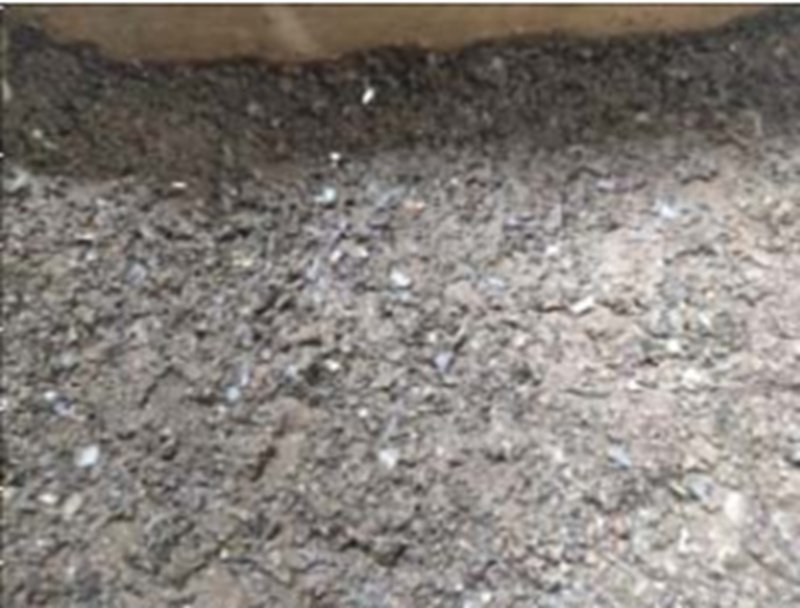
PROPRIETÀ DELL'INOCULO
Un campione di fanghi di depurazione digeriti anaerobici è stato analizzato per il pH, percentuale di solidi secchi, e solidi volatili,
così come, la quantità di sviluppo di CO2 e CH4 durante il test. Tavolo 1 elenca i risultati di questo test iniziale. Si prega di controllare il rapporto di prova completo ASTM D5511
Domande frequenti
L'imballaggio in blister è composto da PET (polietilene tereftalato) o PVC (cloruro di polivinile) imballaggi in plastica. Il materiale PS (polistirene) o PP (polipropilene) verrà utilizzato anche quando c'è tempo Il materiale robusto utilizzato per i blister li rende ideali per un'ampia gamma di applicazioni, come i prodotti farmaceutici, equipaggiamento elettronico, o prodotti giocattolo.
Se la tassa di stampaggio raggiunge il valore del 5‰ del tuo ordine, restituiremo la tassa di muffa. Per esempio, se la tassa di stampo è di 50 USD, può essere rimborsato quando l'importo totale dell'ordine è di 10000 USD.
La maggior parte dei professionisti dell'imballaggio è riluttante a offrire una risposta rapida. Questo perché i costi di imballaggio variano da un tipo di imballaggio all'altro. Alcuni tipi di imballaggio sono naturalmente più costosi di altri, ma tutti di solito beneficiano di volumi più elevati per raggiungere costi unitari inferiori. Contatta il tecnico delle vendite
1.il pacchetto blister ha buone prestazioni di tenuta, può essere impermeabile, a prova di umidità, a prova di polvere, antiruggine e prolungare il periodo di protezione
2.Peso leggero. Il blister è più leggero. Inoltre, il blister ha una certa elasticità e quindi ha una certa prestazione ammortizzante. Il prodotto imballato non richiede materiale di imbottitura aggiuntivo quando è imballato, che consente di risparmiare spazio di archiviazione e riduce il costo dell'imballaggio.
3.Intuitivo. I consumatori possono vedere direttamente la forma e le dimensioni del prodotto attraverso un blister trasparente. Cosa c'è di più, il suo substrato può stampare informazioni di base come il codice del prodotto, nome, numero di parte specifica e codice a barre.
L'usanza generale è di 3000 pezzi, e i prodotti speciali possono essere ridotti a 1000 pezzi. Siamo in grado di fornire rapidamente campioni manuali e grandi quantità di merci per garantire qualità e consegna!Contatta il tecnico delle vendite

